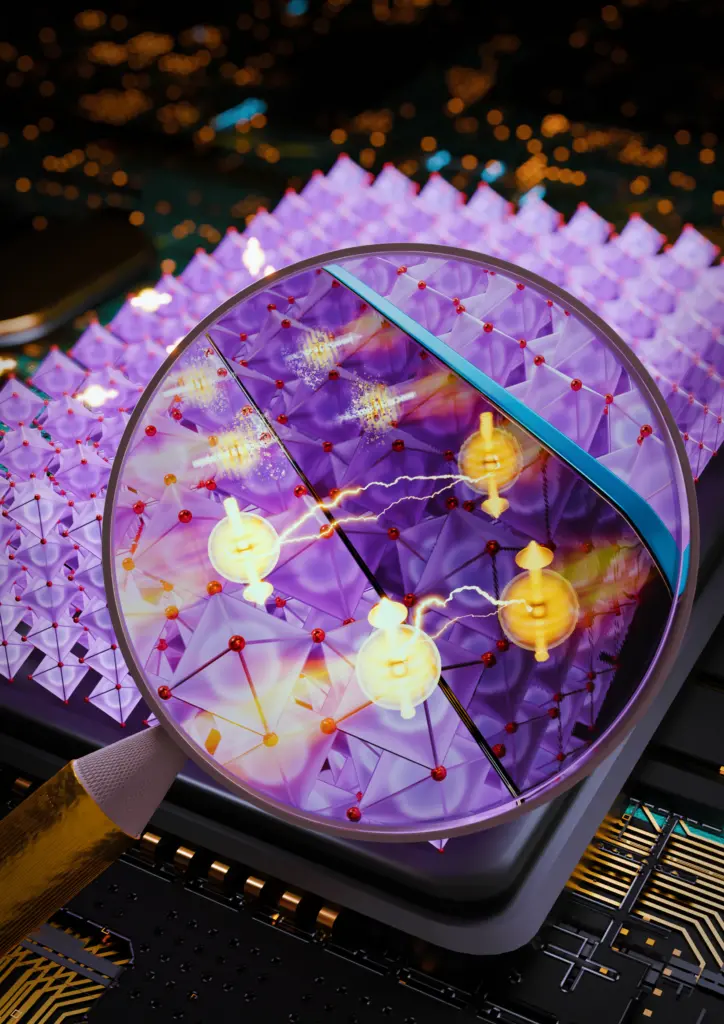Materials science researchers at the University of Wisconsin-Madison have developed a new way of making materials key to smaller, faster and more powerful next-generation computer memory devices.
In the materials advance, the researchers developed a way of growing thin films of oxide crystals in a unique orientation that’s important in spintronics, or “spin electronics.” These fast, efficient electronics use the spin state of electrons to record information. The researchers’ new method controls the natural symmetry of the crystals, allowing them to produce vastly more useful spin currents. It’s a critical step forward in advancing these powerful memory devices.
 Chang-Beom Eom and Mark Rzchowski. Credit: Joel Hallberg.
Chang-Beom Eom and Mark Rzchowski. Credit: Joel Hallberg.
The research, led by Chang-Beom Eom, a professor of materials science and engineering at UW-Madison, Mark Rzchowski, a UW-Madison physics professor, and PhD student Michael Patton, was published in June 2023 by the journal Advanced Materials.
Currently, computers and other electronic devices rely on several types of memory, including hard disk drives and random access memory, or RAM. Each has advantages; hard drives are nonvolatile, meaning they retain information even when the power stops flowing. They’re ideal for long-term storage; however, accessing information stored on them is relatively slow. Conventional RAM, which computers use to process information, is much faster, but when the electricity is switched off, that information is lost.
That’s why researchers are working on spintronic-based memory storage devices. This approach uses a quantum state of electrons called spin, or angular momentum, instead of a positive or negative charge. Spintronics devices do not require an electric current to retain their spin states, so the memory is nonvolatile, like a hard drive, but as fast as, or faster than, RAM.
To record information in conventional memory devices, electrons with positive and negative electric charges are used to flip switches in a magnetic material. In spintronics, however, electrons with different quantum spin states, either “up” or “down,” are separated to create a differential. When the electrons in different spin states pass through the magnetic material as spin currents, they torque the magnetic switches, flipping them.
 By growing iridium oxide crystals in a new orientation, the team was able to create non-conventional spin currents within the material.
By growing iridium oxide crystals in a new orientation, the team was able to create non-conventional spin currents within the material.
These spin-orbit torque devices are currently made out of highly symmetrical crystalline materials that only allow spin currents that are polarized in one direction, referred to as conventional spin current. Devices made from these materials are limited in their ability to flip the magnetic switches. In particular, they cannot optimally flip magnetic switches pointing up out of the film, the most favorable orientation for tightly packing information into the magnetic switches.
In its research, the UW-Madison team found that controlling the crystalline symmetry of the materials led to control of the spin polarization direction, and the ability to design the exact nature of the spin current. They used epitaxy, a method of growing thin layers of crystals, to rotate the orientation of the highly symmetrical material iridium oxide. As a result, they reduced the relative crystal symmetry, which allows for non-conventional spin currents, as well as the in-plane current. Now, their material allows for spin currents in multiple directions within the same material.
“Conventionally, you can only do this in plane, which is very low density,” says Eom. “But by designing this orientation of the crystal, we can use three different types of spin current in one material. This means you can have a device with much higher density that uses a smaller space.”
The researchers will now be able to apply what they’ve learned to other materials. “The novelty of this study isn’t the material iridium oxide; the novelty is the way we reorient the crystal structure to unlock unique spin transport,” say Patton. “The same method can be applied to other materials of choice. If you have theoretical predictions of the spin transport for a given orientation of a material, then you can calculate and predict unconventional spin transport in any orientation using simple matrix rotations.”
Chang-Beom Eom is the Raymond R. Holton Chair for Engineering and Theodore H. Geballe Professor.
Other authors include Evgeny Y. Tsymbal, Gautam Gurung, and Ding-Fu Shao of the University of Nebraska, Lincoln; Gahee Noh and Si-Young Choi of the Pohang University of Science and Technology in Korea; Joseph A. Mittelstaedt, Marcel Mazur and Daniel C. Ralph of Cornell University; Jong-Woo Kim of Argonne National Laboratory; Philip J. Ryan of Argonne National Laboratory and Dublin City University, Ireland; and Tianxiang Nan of Tsinghua University, China.
The researchers acknowledge support from the Vannevar Bush Faculty Fellowship (ONR N00014-20-1-2844), the Gordon and Betty Moore Foundation’s EPiQS Initiative, Grant GBMF9065. Transport measurement at the University of Wisconsin–Madison was supported by the U.S. Department of Energy Office of Science, Office of Basic Energy Sciences, under award number DE-FG02-06ER46327.
Featured image caption: PhD student and co-author Michael Patton used epitaxial techniques to grow iridium dioxide with a rotated crystal structure, changing its relative symmetry and allowing for non-conventional spin currents. Credit: Joel Hallberg.